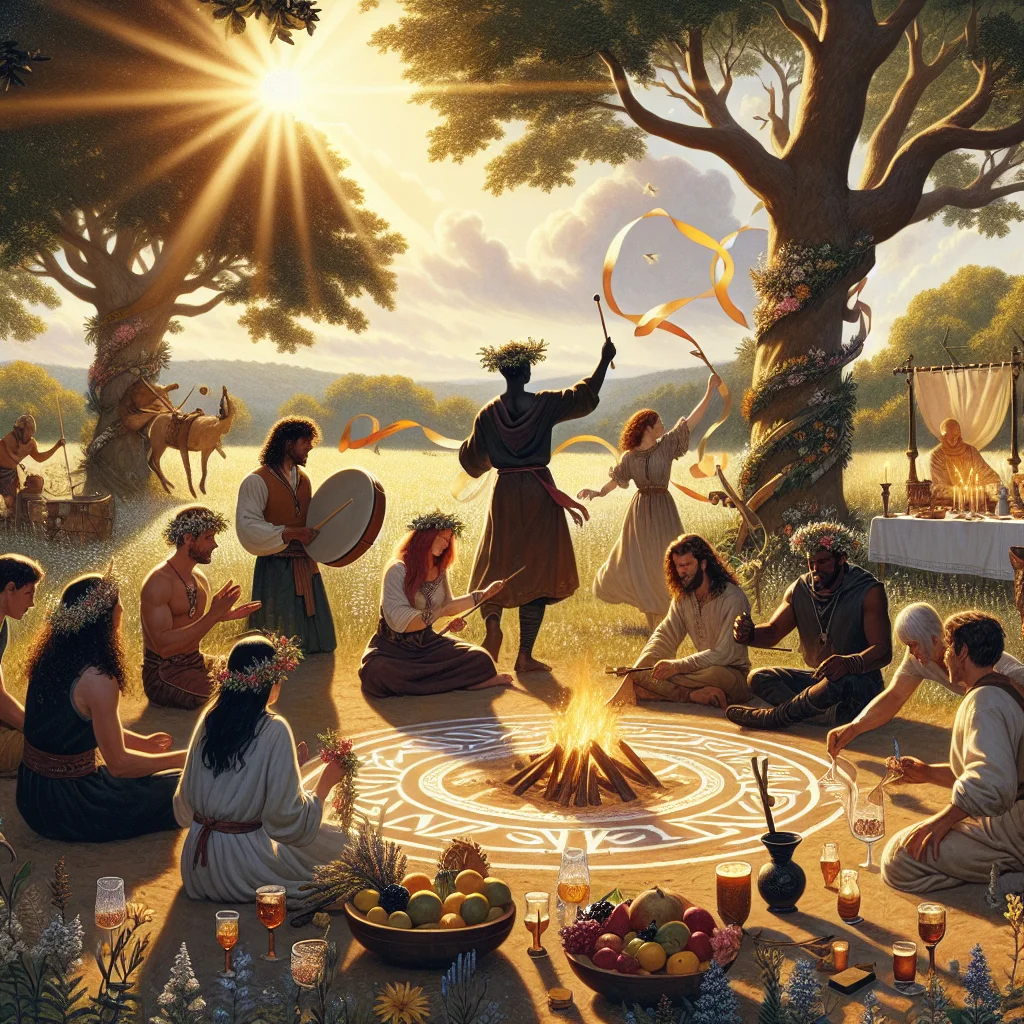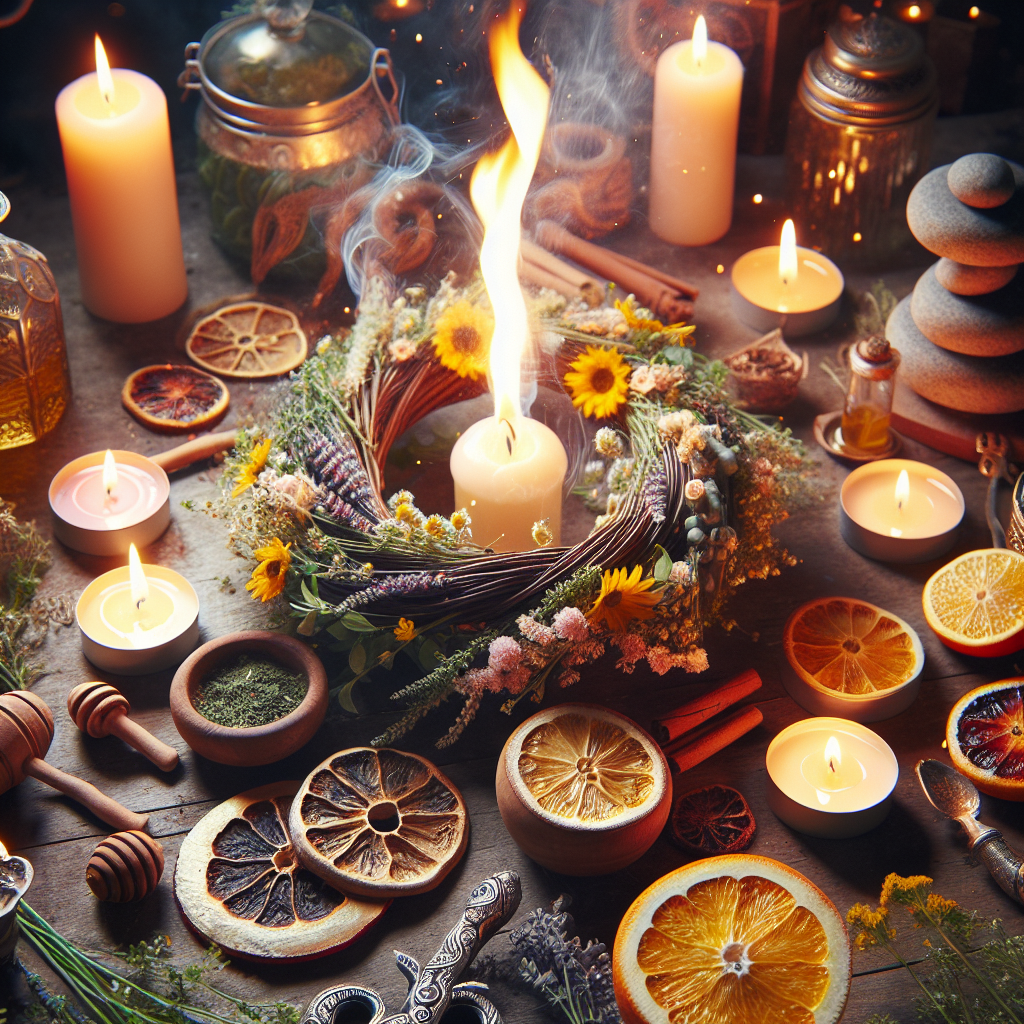As an Amazon Associate I earn from qualifying purchases.
Litha, also known as Midsummer, is a celebration of the summer solstice, the longest day of the minyear. Traditionally observed in various forms across Europe, Litha honors the peak of the sun’s power and the apex of its journey across the sky. This ancient festival marks a time when the boundary between the earthly and the supernatural is considered especially thin, a day full of magic, when fairies are said to be afoot and the spiritual realm is close.
The roots of Litha trace back to pre-Christian times, with echoes found in the Celtic festival of Beltane and the Norse rituals honoring the sun goddess Sunna. With the spread of Christianity, many pagan traditions were adapted and woven into the fabric of Christian feast days. In contemporary times, Litha is celebrated by various pagan communities, including Wiccans and Druids, as an opportunity to give thanks for the light and to meditate on the dynamic balance between fire and water, growth and decay, abundance and dormancy.
Litha is often characterized by the lighting of bonfires, believed to boost the sun’s energy for the remainder of the crop-growing season and to drive away evil spirits. Communities gather to leap over the flames, a practice thought to purify the spirit and bring good fortune. In an attempt to harness the sun’s power, it is also customary to rise at dawn on the day of the solstice to witness the sunrise, engaging in rituals of reflection and renewal.
A compelling aspect of Litha celebrations involves the weaving of magic and intention into everyday life. For example, individuals might craft charm bags filled with herbs like lavender or St. John’s wort, which are said to be at their most potent during the solstice. Garden blessings are another common practice, where water infused with the power of the solstice sun is used to sprinkle on plants to encourage growth and ensure a bountiful harvest.
Engaging in Litha celebrations can serve to deepen one’s connection with the natural cycle of seasons and the environment. In a world where climate change remains a pressing concern, these rituals offer a moment to reflect on the sustaining power of the sun and the importance of living in harmony with the earth. With millions celebrating the solstice worldwide, Midsummer stands as a testament to the enduring appreciation for the sun’s life-giving force and the perpetual dance of the earth around it.
“`html
What Are the Rituals for Celebrating Litha During the Summer Solstice?
“`
Litha, also known as Midsummer or the Summer Solstice, is a time of celebration for many pagans and Wiccans around the longest day of the year, typically falling on June 21st. It is a festival that honors the sun at its peak of strength, symbolizing abundance, growth, and the power of light. The rituals often involve lighting bonfires, feasting with seasonal produce, and performing magick that draws on the sun’s energy for personal empowerment and community blessings. These practices are rooted in ancient traditions and reflect the harmony between humankind and the natural cycle of seasons. The celebration offers an opportunity for participants to reflect on personal growth and to embrace the vibrant energy of summer. To learn about how Litha is celebrated today and how you can incorporate its rituals into your own seasonal observances, read on for an in-depth exploration of this joyous and luminous festival.
Litha Celebration Ritual for Summer
Litha, also known as Midsummer or the Summer Solstice, is the pinnacle of the solar year when the sun reaches its highest point in the sky, typically occurring around the 21st of June in the Northern Hemisphere. It is a time of maximum daylight, vibrancy, and strength. The day marks the longest period of daylight and is a celebration of the sun at its peak power. Celebrating Litha is a tradition that dates back to ancient times, with rituals designed to honor the power of the sun and the abundance of the growing season.
Creating a Sacred Space
The first step in any Litha celebration ritual is to create a sacred space. This can be done indoors or outdoors, but many prefer to be outside to connect directly with the sun’s energy. The chosen area is often decorated with symbols of the season, such as sunflowers, oak branches, and colors that represent the sun such as gold, yellow, and orange. An altar can be set up with candles, crystals like citrine or sunstone, and summer herbs like St. John’s Wort, mugwort, and vervain, which are believed to have potent properties during this time.
Lighting the Midsummer Fire
The fire has always been at the heart of Litha celebrations. Traditionally, people would leap over the Midsummer bonfire, believing it would purify them, bring luck, and restore vitality. Modern practitioners often light a smaller flame in a cauldron or a fire pit, symbolizing the sun at its utmost power. Participants can write down things they want to dispel from their lives and cast the papers into the fire, releasing them to transform.
Sunrise Observance
Witnessing the sunrise is a critical element of the litha celebration ritual. Observers wake early to greet the sun on this, its longest day. Some may practice Sun Salutations, a sequence of yoga poses that pay homage to the sun, while others might simply sit in quiet meditation or chant to greet the sun as it rises.
As Litha is a festival celebrating the earth’s bounty and the power of nature, participants engage in rituals connecting them with the natural world. This can include walking barefoot on the earth, also known as “earthing” or “grounding,” which is believed to bring one’s body into balance with the earth’s energy. Planting seeds or tending to gardens are also common practices, signifying a connection to the life-giving aspect of the sun.
Herbal Magic and Craftsmanship
The potent energy of herbs is another feature often incorporated into Litha rituals. Crafting herbal amulets or making seasonal wreaths with herbs and flowers is a way to capture the essence of the sun’s energy. Herbs gathered at Midsummer are said to be extremely powerful, and many people create protective sachets or infusions with herbs such as lavender, chamomile, or yarrow.
Feasting and Community
Community is a significant part of many Litha celebrations. Sharing a feast with friends and family honors the abundance of the season. Foods often include seasonal fruits and vegetables, such as berries, which are at their peak around the solstice.
Indeed, statistics reflect the importance of community in seasonal celebrations; surveys conducted in various countries show that over 80% of individuals report that sharing meals with friends and family is a key aspect of celebrating seasonal events, indicating the communal nature of such occasions.
By integrating these various elements, practitioners create a multi-faceted ritual that resonates with the energy of the sun, the earth, and the community. Litha is not only a time for joy and celebration but also for grateful acknowledgment of the sun’s life-sustaining power and a time for personal growth and renewal.
- What is Litha and when is it celebrated?
Litha, also known as Midsummer or the summer solstice, is a pagan festival celebrated on the longest day of the year, which typically falls around June 21st in the Northern Hemisphere. It marks the peak of summer and the high point of the solar year.
- What is the significance of a Litha celebration ritual?
The Litha celebration ritual is significant for honoring the power of the sun, the abundance of the earth, and the fullness of life. It is a time to give thanks for the light and warmth that nourish the crops and the soul, and to celebrate the strength and fertility that summer brings.
- Is Litha a religious celebration?
Litha has roots in ancient pagan traditions and is often celebrated by those who follow Wicca, Druidry, and various forms of Neo-Paganism. While it has religious elements for some, others may celebrate it as a cultural or seasonal festival without religious connotations.
- Can anyone celebrate Litha, or is it restricted to certain religious paths?
Anyone interested in honoring the themes of Litha, such as the sun’s energy, the Earth’s abundance, and the joy of summer, can celebrate. There are no restrictions on who can participate, and many people from diverse backgrounds find meaning in the celebration.
- What are some common Litha celebration rituals?
Common Litha celebration rituals include lighting bonfires, spending time outdoors, feasting with seasonal foods, creating sun-themed altars, performing sun salutations, and crafting with natural materials. Celebrants often incorporate flowers, herbs, and symbols of the sun into their rituals.
- How can I create my own Litha altar at home?
To create a Litha altar at home, gather items that symbolize the sun, such as candles, sunflowers, and golden crystals. Incorporate seasonal elements like fresh herbs and fruits, and consider adding personal items that represent growth, vitality, and light. Arrange them in a way that feels balanced and harmonious to you.
- Are there any traditional foods associated with Litha?
Yes, traditional Litha foods often include fresh fruits, especially berries, herbs from the garden, honey, and any other seasonal produce. Food is typically light and celebratory, reflective of the abundance of the summer season.
- What is the purpose of lighting bonfires during Litha?
The lighting of bonfires during Litha is an ancient tradition that symbolizes the power and light of the sun. Bonfires are also thought to encourage the sun’s strength to continue throughout the rest of the growing season and ward off evil spirits.
- Is Litha an official holiday?
Litha is not an official holiday in the modern, secular sense, and most countries do not recognize it as a public holiday. However, it is an important date in the calendars of those who follow pagan or earth-centered spiritual paths.
- What can I do if I don’t have a community to celebrate Litha with?
If you don’t have a community to celebrate Litha with, you can still observe the festival by creating your own personal ritual. Solo activities can include meditating in sunlight, crafting a small altar, taking a nature walk, or simply reflecting on personal growth and the abundance in your life.

Conclusion
The Litha celebration ritual, marking the summer solstice, is a time-honored point of reflection where participants honor the brightest day of the year, the strength of the sun, and the full bloom of nature. It is a joyous period that traditionally embraces the balance between fire and water, symbolizing the balance of light and life. Key points in the ritual include the creation of an altar adorned with seasonal flowers, herbs, and symbols of the sun, which serve as focal points for the energy of the celebration. Participants engage in activities such as bonfires, which are emblematic of the power and presence of the sun, and rituals that emphasize personal growth, abundance, and gratitude. The intertwining of ancient customs and modern interpretations allows practitioners to connect with the rhythm of the seasons and the energy of the earth.
Insights gained from the Litha celebration ritual reveal its significance in fostering community, self-reflection, and an appreciation for the cyclical nature of life. Through the performance of traditional dances, crafting of protective amulets, or the sharing of seasonal foods, individuals are reminded of the interconnectedness of all living things and the importance of nurturing the light within. As the Litha ritual concludes, participants leave with a renewed sense of energy and empowerment, carrying the vibrant, life-affirming energies of summer into the rest of the year, and cherishing the memories and intentions set during this peak of sunlight and warmth.
Amazon and the Amazon logo are trademarks of Amazon.com, Inc, or its affiliates.


